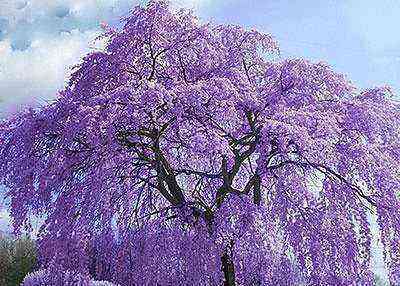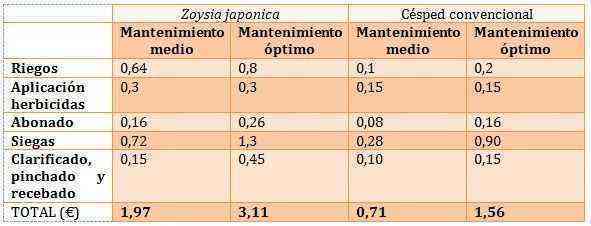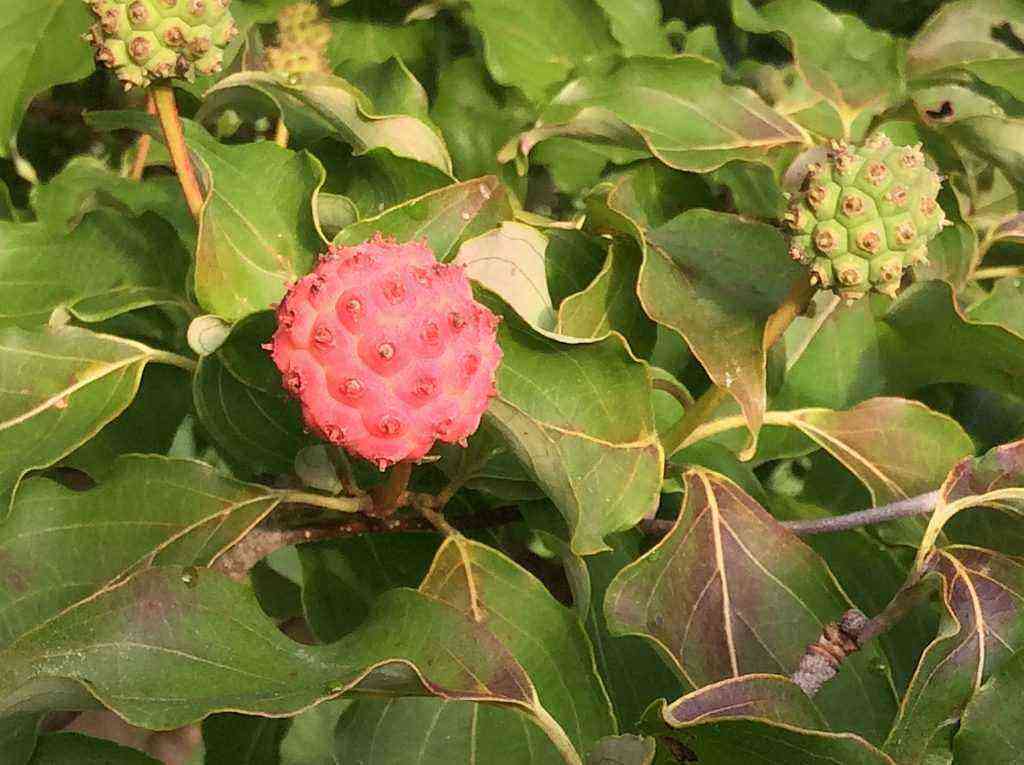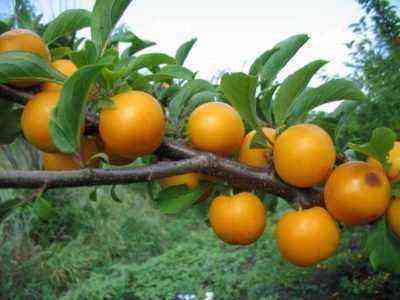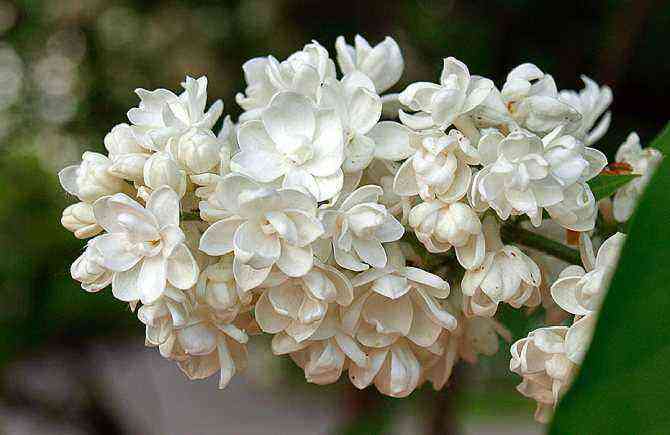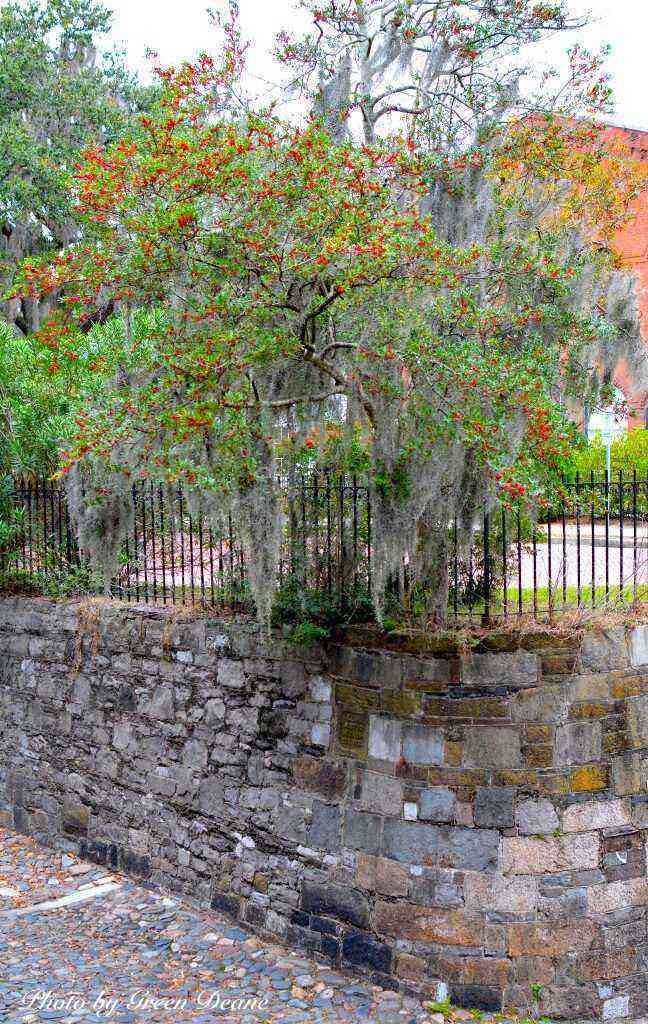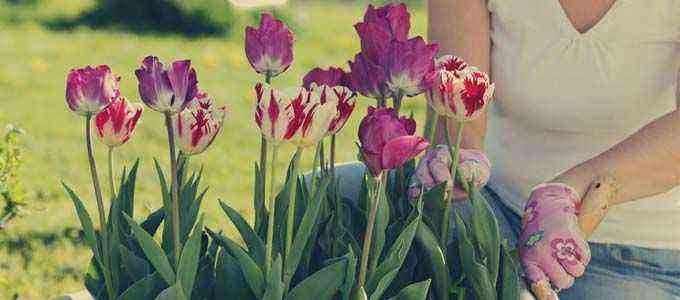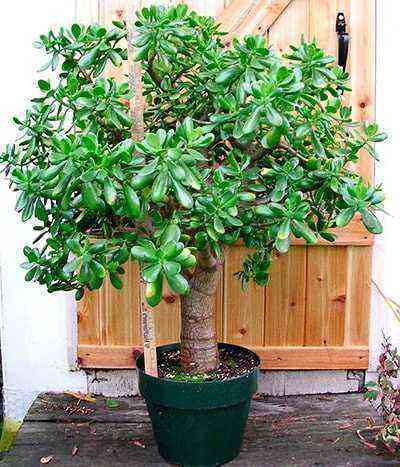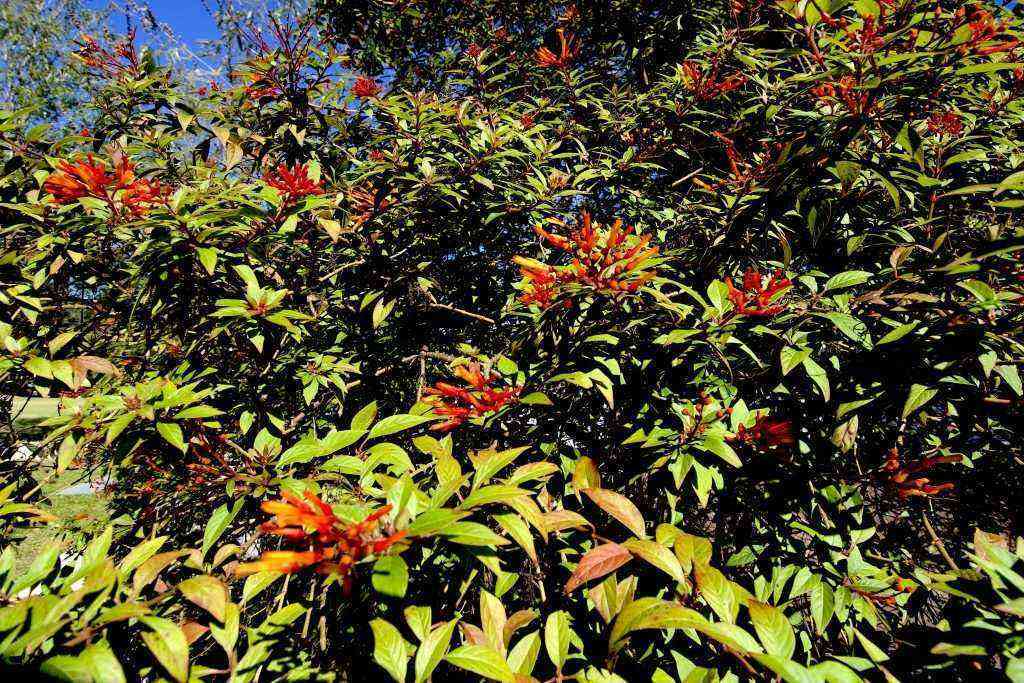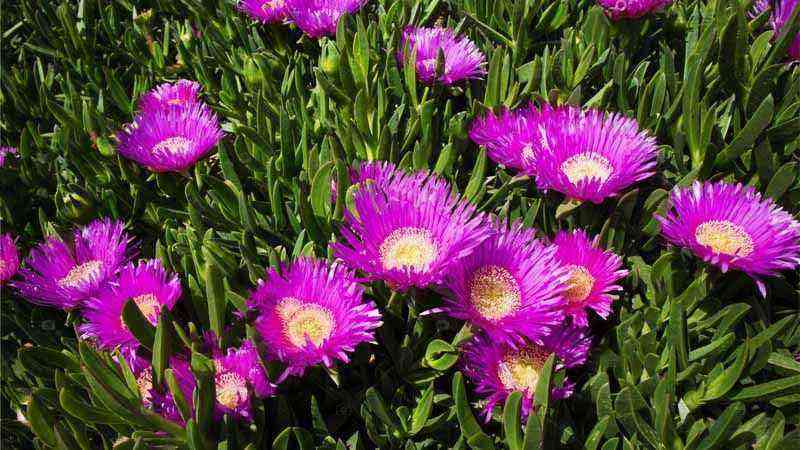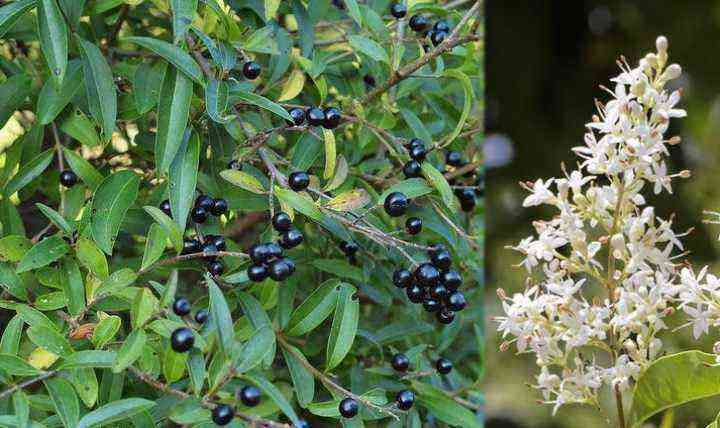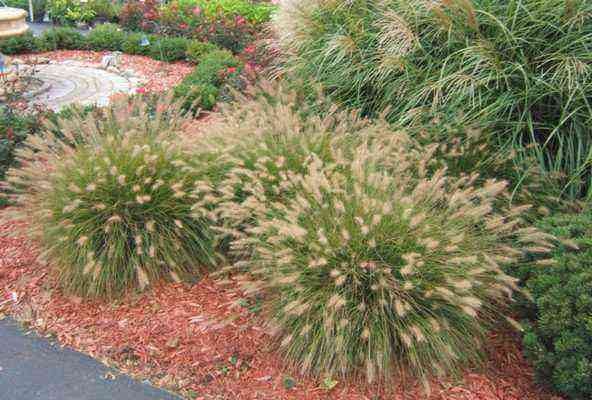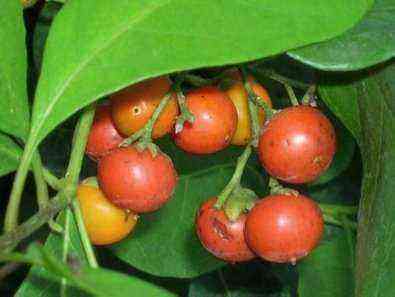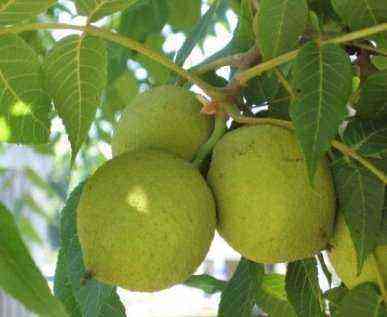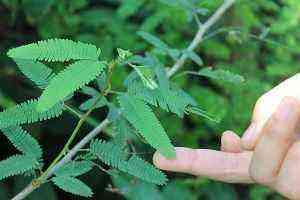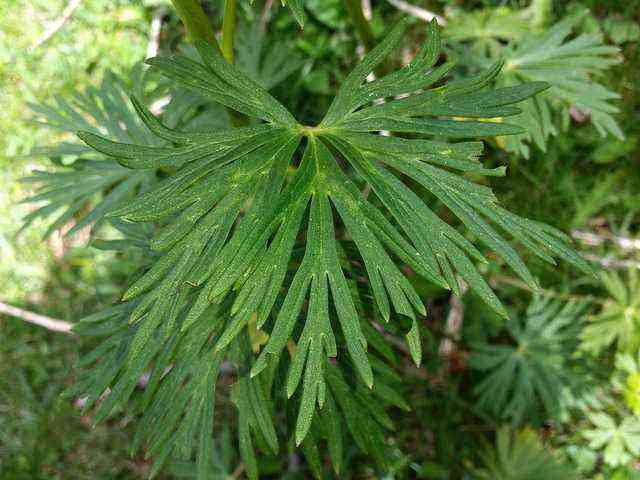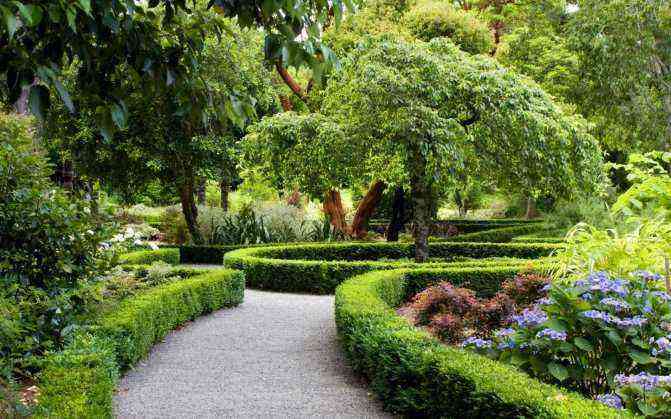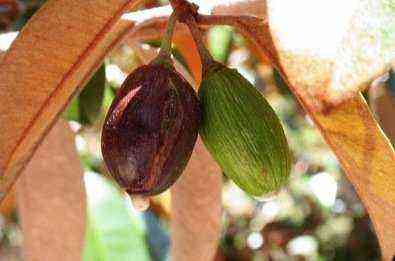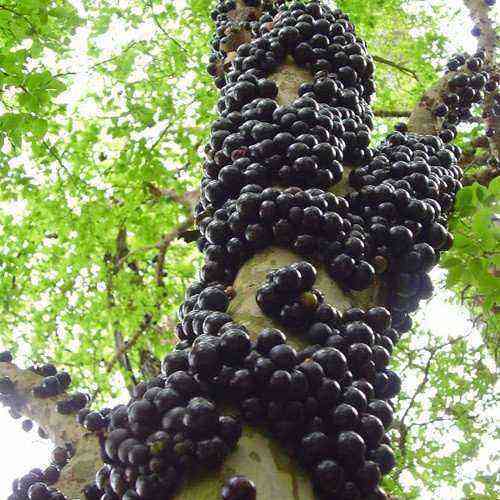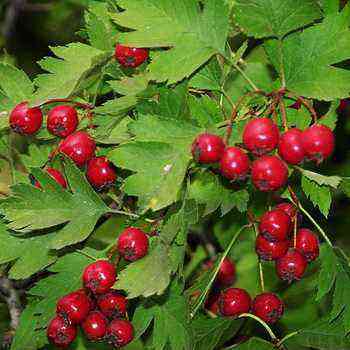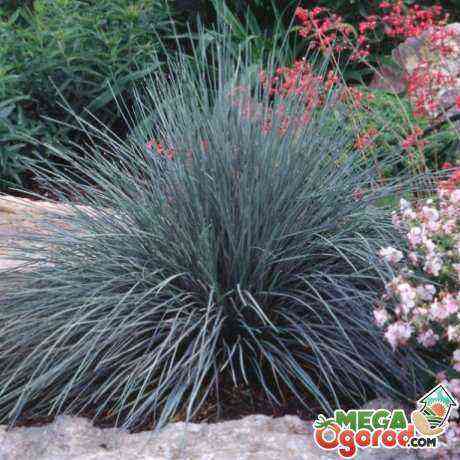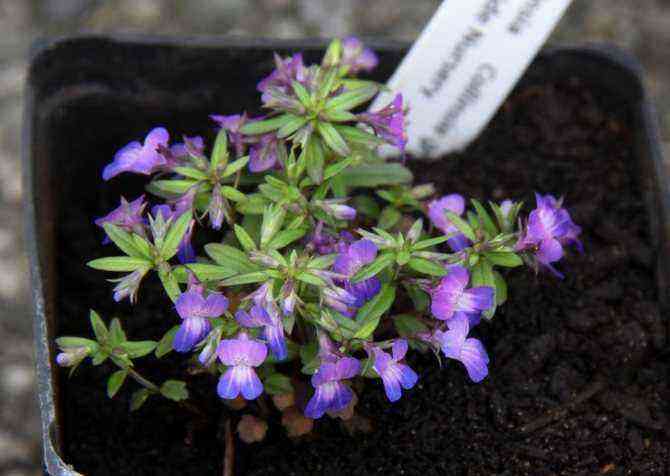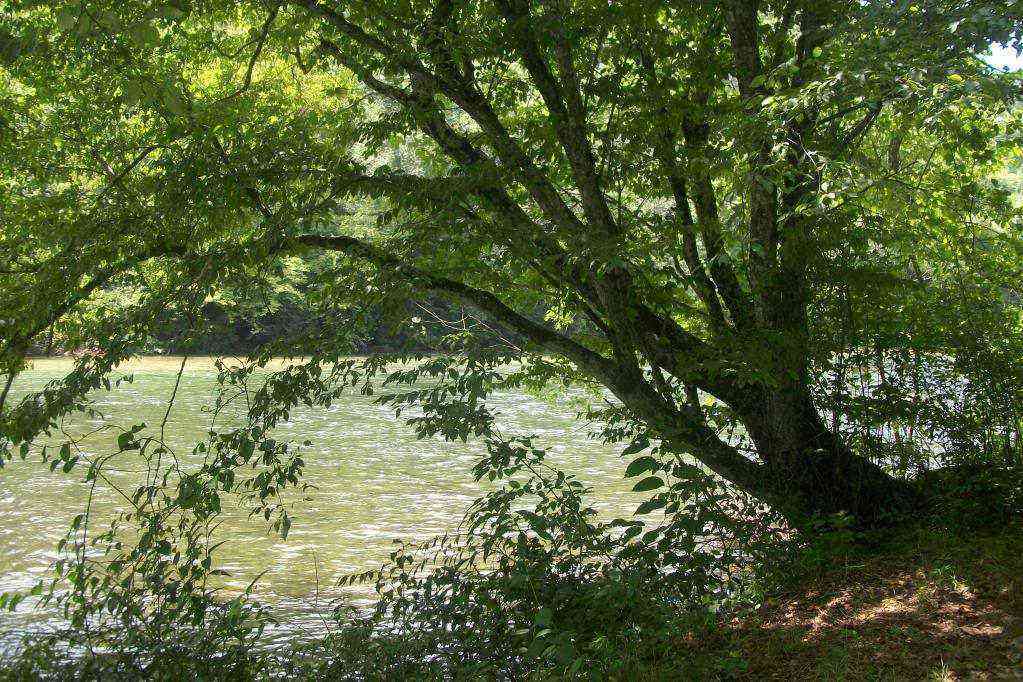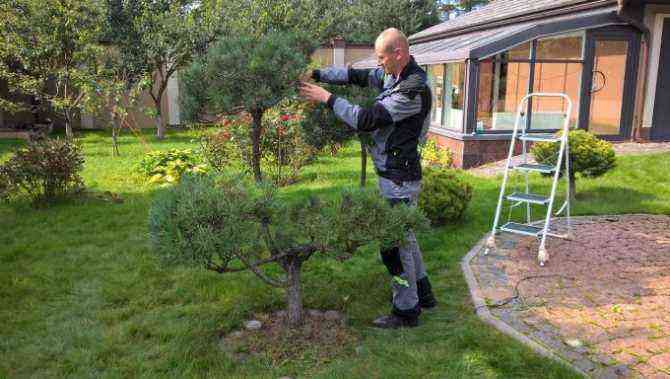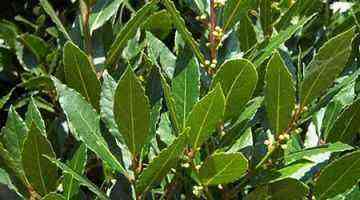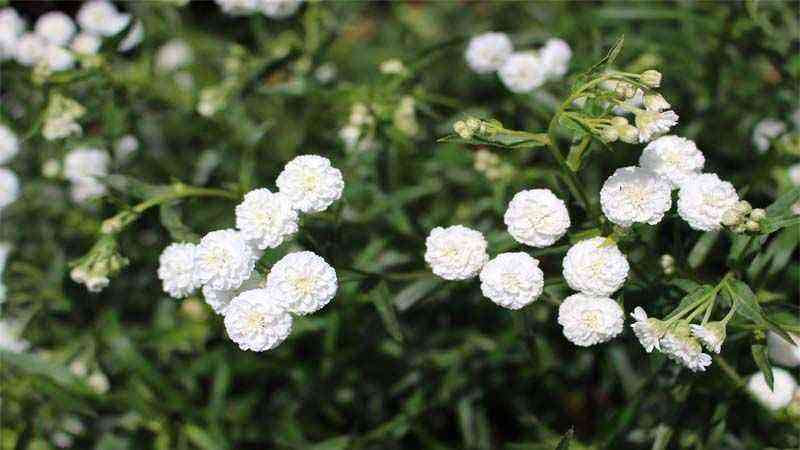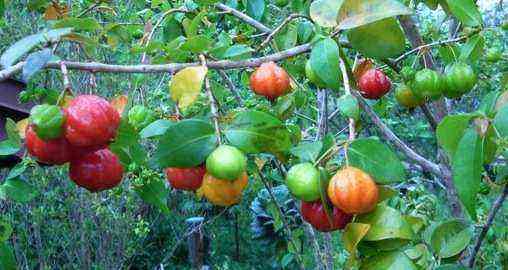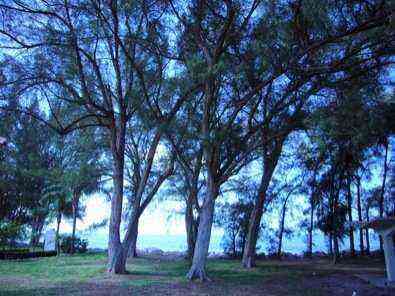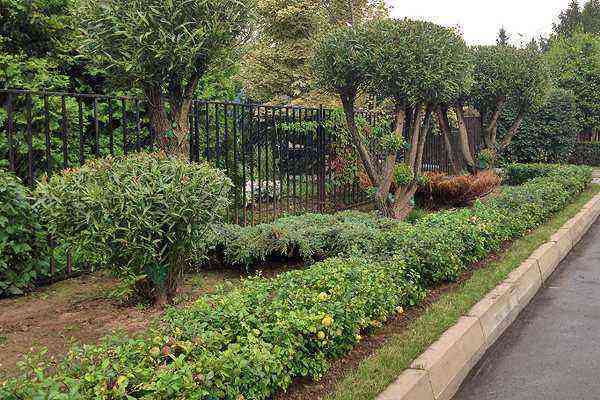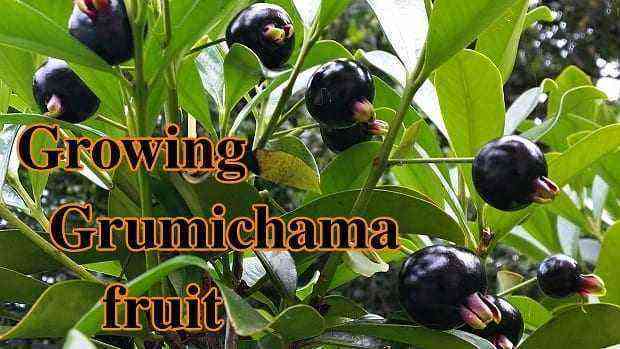Description of the plant
Jacaránda is a tree-like plant from the Bigonia family that grows in South America (Brazil, Mexico, Bolivia), Africa (Zimbabwe) and Australia in tropical and subtropical plains and mountainous regions. The name “jacaranda” is translated from Portuguese as “having hard wood”. Locals call these plants Black Pui, a fern tree, for the shape of its leaves, pink, violet or rosewood tree.
The trees can reach a height of 20-30 meters, but there are shrub plants among them, no higher than 2 meters. They belong to the semi-leafy species, if the ambient temperature drops to 0 ° C, then the leaves may fall off. Young plants die at -3 ° C, and adults rarely survive below -7 ° C.
Their leaves are fern-like, feathery, bright green in color. The bark can have various shades: from red to chocolate and even purple. The shape of the flower resembles a bell, about 5 cm long. They are collected in clusters containing 30-50 flowers. Petals can have a wide variety of shades from white to blue, blue, purple. The tree blooms in October-November very profusely, under the weight of the flowers, the branches tilt to the very ground. The sticky sweet nectar and fragrance in the air attracts insects that pollinate the flowers. The flowering period lasts 1,5-2 weeks. After wilting, seed pod-shaped capsules form in place of the spectacular flowers. Ripe capsules burst, and lionfish seeds scatter over long distances.
Having a very decorative appearance, jacaranda is used for landscaping streets, parks, squares in cities in Africa, Australia, and South America. But it is not only the appearance of the trees that is appreciated. They have very hard, durable wood, valuable qualities are in demand in the manufacture of furniture, musical instruments, various souvenirs, interior items, and so on. In the process of processing, the core of the tree acquires a beautiful color – red-brown with a purple tint.
Using
We have already mentioned that the valuable species of jacaranda wood is highly regarded in the world. It is known as rosewood, which is used for the production of luxury furniture, unique luxury items (inlaid with metal and carved products). In addition, magnificent musical instruments are made from this wood.
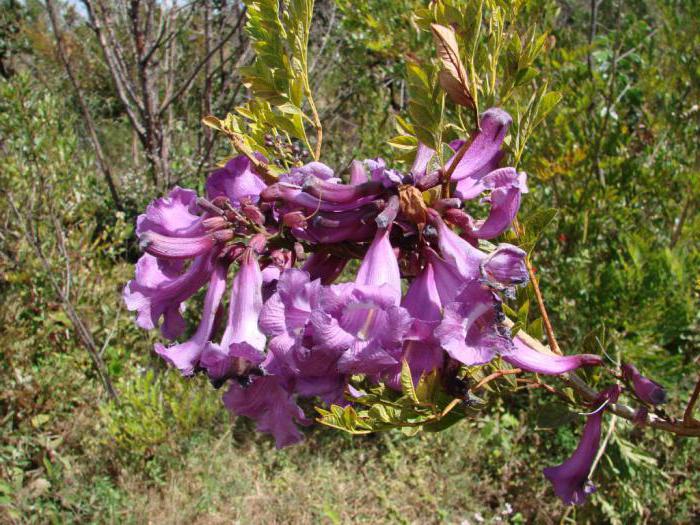
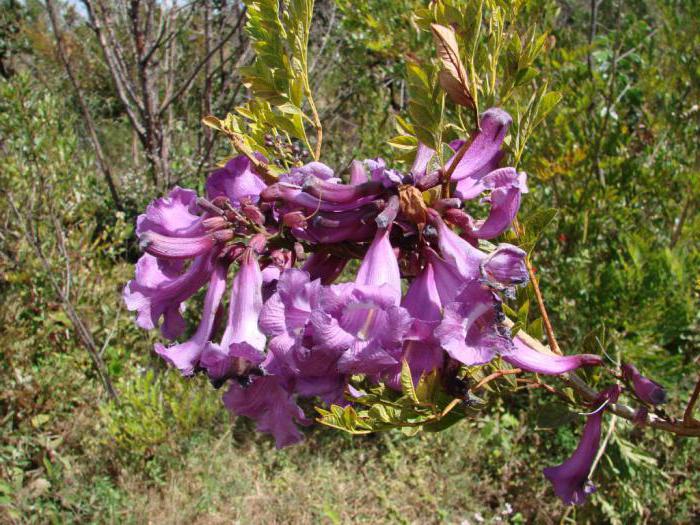
When polished, the wood core becomes a beautiful brown color with a purple sheen. For example, in Brazil, you can see and buy jacaranada souvenirs – carved figurines of exotic animals. They have a very pleasant delicate smell, especially when you wipe them with a cloth.
The magical properties of jacaranda
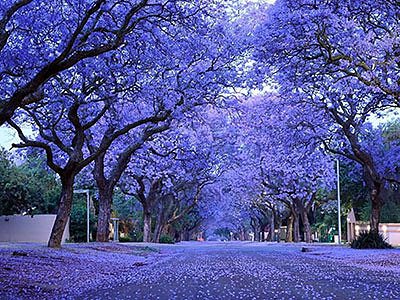
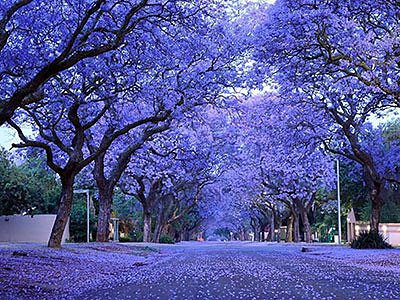
In the tribes on whose lands the violet tree grows, there are many legends, myths, and signs associated with it. In Australia, for example, he is associated with the daughter of the Moon, who flew to Earth on the bird Mitu. A beautiful girl brought people knowledge, wisdom, which she generously shared with them, sitting at the foot of a wonderful tree. Now in Sydney and other Australian capital cities, jacaranda grows near almost every university. And students believe that if, while going to the exam, they catch a flying violet flower, or if it falls right on their heads, then success during the delivery is guaranteed.
Some African tribes believe that the Blue Spirit dwells in the crown of the tree. He helps to make the right decision in difficult, difficult or conflict situations. For other peoples, the rosewood tree serves as a kind of amulet for babies. According to tradition, when a baby is born, parents plant a new tree in his honor.
Jacaranda as a houseplant
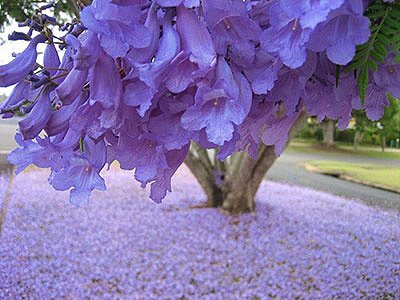
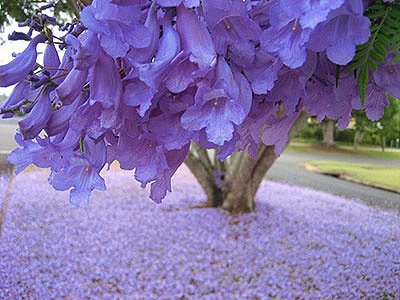
The violet tree is not adapted to the climatic conditions of Russia. However, many Russian indoor gardening enthusiasts grow it indoors, in greenhouses, conservatories. A jacaranda indoor flower can reach a height of 2 meters, so it is quite difficult to grow it in a standard apartment.
The plant does not contain or emit toxic substances; it is completely safe for both young children and pets. Taking into account the decorativeness and pleasant aroma, exuded not only by flowers, but also by the plant itself, it is compared with lilacs, jasmine, sakura. But it should be borne in mind that in enclosed spaces it is very rare to find a blooming violet tree. He is loved for decorativeness: beautiful leaves, graceful stem.
Indoor jacaranda is unpretentious. It can be kept both in the sun and in partial shade. In summer, the plant needs frequent watering, spraying. In winter, you can water less often, once every 1-3 weeks. But you need to provide additional lighting. In order for the plant to be comfortable, a large volume container will be required for growing.
The violet tree also thrives when grown in the bonsai style. To do this, it is better to purchase a violet tree of the Bonsai Blue variety. These plants reach a height of no more than 75 cm.Cultivation technology assumes compliance with the following conditions:
- in the second year after planting, the top of the plant is shortened with a sharp pruner to a height of up to 10 cm, after which lateral shoots should form on the trunk;
- after that, they begin to form the crown, carefully pinching the shoots and pruning the leaves;
- to create an original shape, the crown can be strengthened with a soft wire, which after 3 months, after the lignification of the shoots, will need to be removed;
- large leaves must be cut off;
- for more intensive branching, the plant is kept in the sun.
Florists who grow a violet tree at home as an indoor flower believe that it has a beneficial effect on the atmosphere in the family, brings good luck, promotes well-being and financial wealth, fills the soul with peace and harmony.
Placement
Jacaranda prefers bright lighting, about 3 hours she carries the direct rays of the sun. The plant feels comfortable near the western and eastern windows. The pot needs to be rotated periodically, since one-way lighting can distort the crown.
The temperature required for the normal development of the plant in summer is +25 ° C, in winter – +19 ° C. In summer, Jacaranda loves to “walk” in the air. At the same time, the place where you take the flower should be protected from the wind.
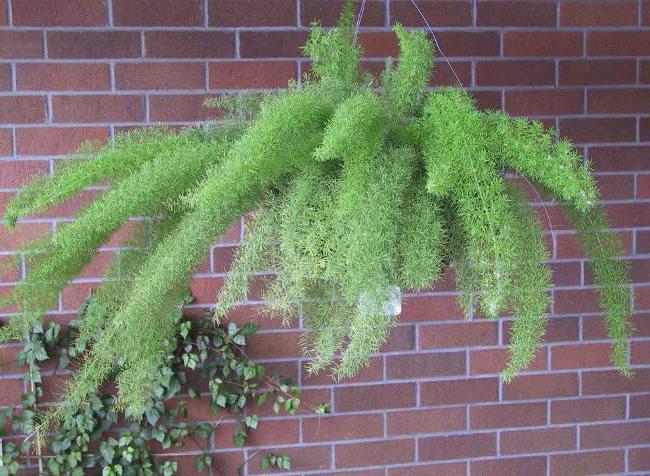
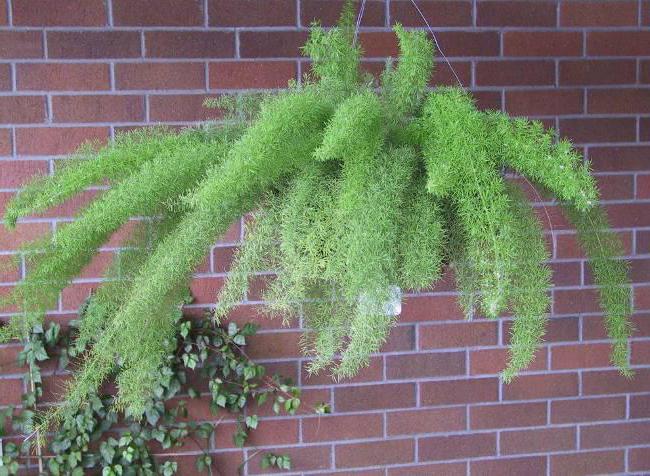
Jacaranda (violet tree) in Russia is the dream of many gardeners. But how to care for this exotic plant? Violet tree is regularly watered, drying out the soil is unacceptable. In winter, watering is slightly reduced. Only soft water should be used; it should have room temperature.
Jacaranda is a tropical plant, so it needs moist air. To make him comfortable in the room, he needs to be sprayed regularly.
Violet tree needs top dressing. In spring and summer (during the growth period), the plant is fed with complex fertilizer no more than twice a month. Every spring, the jacaranda is cut off. Gradually, its old leaves fall off, the trunk is exposed. That is why pinching the shoots will rejuvenate the plant and add splendor to its crown.
Transplantation is performed as needed, most often in the spring, when you see that the root system occupies the entire volume of the pot.
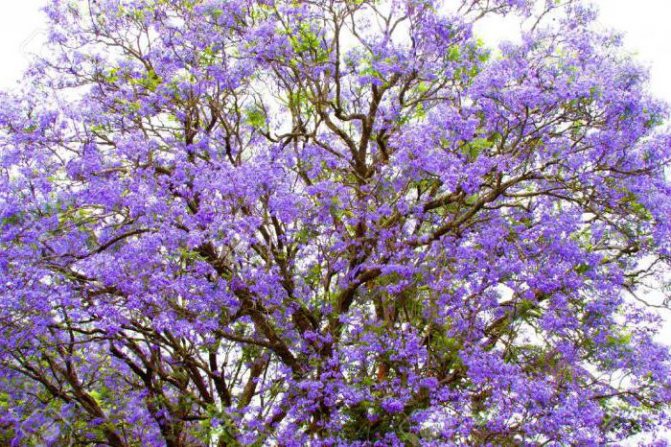
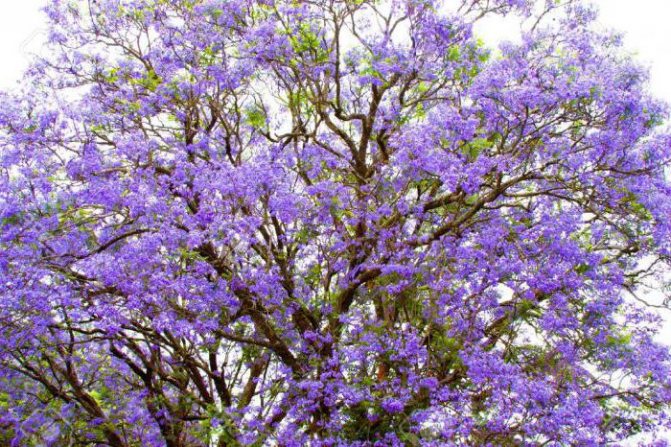
Jacaranda care


In total, more than 50 types of jacaranda are known, but only two varieties are suitable for growing indoors: mimosa, the leaves of which resemble mimosa leaves, and fluffy, which is also called jasmon. For keeping in the room, mainly young plants are used, since adults usually do not have leaves on the lower branches, which reduces their decorative qualities.
Most growers note that the violet tree does not bloom when grown as an indoor flower. Obviously, this is due to the fact that the plant does not have enough space. As the flower grows and develops, it must be periodically planted in a larger container, it can be an ordinary ceramic pot or tub.
Reproduction of jacaranda cuttings
Carry out cuttings from late spring to mid-summer. Cut apical or stem cuttings about 8 cm long, process with root. Plant in a wet peat-sand mixture, cover with a cap and maintain the air temperature at least 25 ° C. Plant the rooted cuttings in separate containers.
Cutting jacaranda in water photo
Jacaranda is also good in water: keep them in the root solution for the first day, and then put them in clean water. Roots will appear soon. If the roots are 1 to 2 cm long, plant new seedlings in separate pots.
Jacaranda – features of care and cultivation in indoor conditions


Home page »Jacaranda – features of care and cultivation in indoor conditions
An unusually beautiful jacaranda tree grows on the damp river banks in the tropics of Brazil and South America. This is a plant from the Bignoniev family. They say it brings good luck. Often in the house where the child was born, locals plant a jacaranda, the so-called violet tree.
In Australia, the jacaranda blooms in October-November. This time coincides with the end of the school year, the beginning of exams for schoolchildren and students. In this regard, residents call it an examination. A flowering broom falling on your head will bring good luck to the one going to the exam.
Evergreen rosewood tree of medium to large size, appreciated not only for its decorative effect, but also for its wood. There are about fifty species of this plant.
Traditions and beliefs associated with jacaranda
In Australia, the jacaranda tree is very fond of.
October-November – the end of the school year on the mainland and the flowering of the fern tree are closely associated with student culture. Students even call it an examination tree, because it is believed that if a blooming jacaranda panicle falls on its head, success in exams is guaranteed. The tree is believed to bring good luck.
An interesting tradition is to plant a plant with the birth of a child. In the 30s and 40s, in the city of Brisbane, jacaranda seedlings were even officially issued in maternity hospitals. Grafton hosts a festival dedicated to this beautiful tree every October.
Species and varieties
In nature, there are more than 50 species of violet trees and shrubs. But for keeping in indoor conditions, only two types have been cultivated: mimosolous jacaranda and jasmine-shaped or fluffy jacaranda (jacaranda tomentosa).
Fluffy Jacaranda (felt)
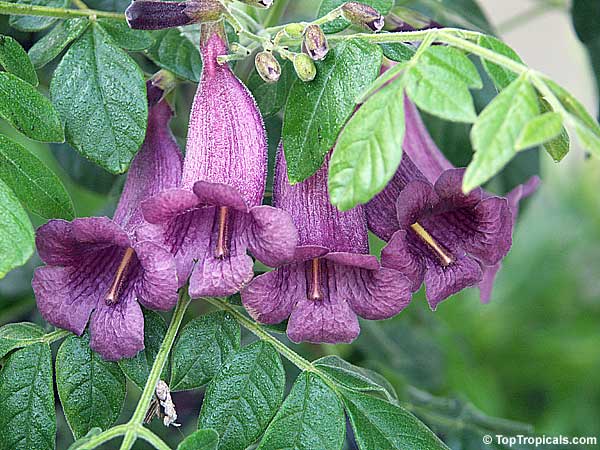
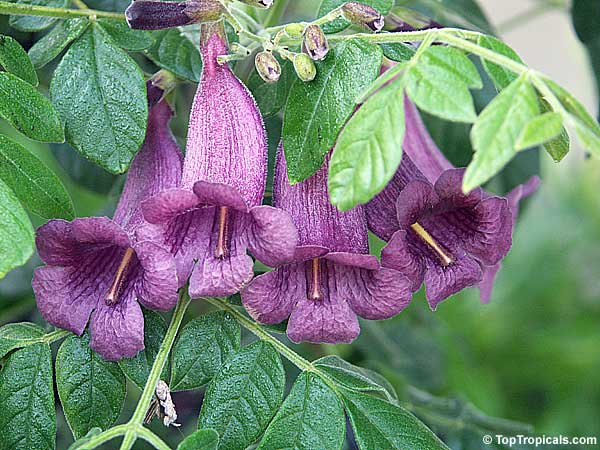
Fluffy Jacaranda (felt)
At home, in South America, its height can reach 15 meters. Complicated feathery leaves are collected from 8 lobes. The flowers of the jasmine jacaranda are smaller, collected in paniculate inflorescences. Shades range from golden to purple. At home, young specimens are grown, since, as they mature, the plant loses its attractiveness.
Jacaranda mimosifolia
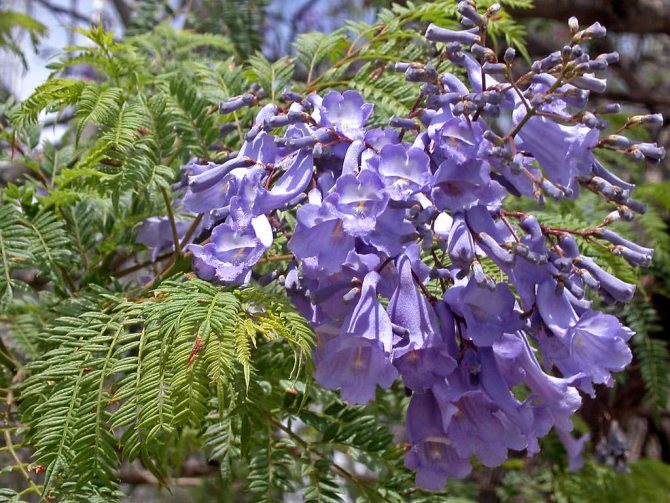

Jacaranda mimosifolia
Other names are round-leaved or oval-leaved Jacaranda (Jacaranda ovalifolia). On the banks of the rivers of Brazil, Argentina and Bolivia, it grows in the same way as the previous species. It is 15-20 meters high, although in indoor conditions it reaches only 2-3 meters. The leaves resemble mimosa leaf plates, very large, feathery, located far from each other opposite. Elongated in shape, with pointed tops.
It blooms very profusely and amicably with blue or purple flowers. Paniculate inflorescences are collected from buds 5 cm long and 3 cm in diameter.
This type of plant is the only one that can be grown at home. Mimosa Jacaranda has two varieties for growing at home – Delta and Magdalena.
The variety is classified as a fast-growing plant. In indoor conditions, it reaches no more than 3 meters in height. The leaves, like all of its relatives, are feathery, compound, oddly located. Painted in light green tones. It is very difficult to achieve flowering, it can bloom only in the open field of greenhouses or greenhouses. From the pot, the plant should be transplanted into open soil after the plant has reached 2 meters.
Often used in offices, shops.
Jacaranda delta is a deciduous ornamental plant for indoor cultivation. Fern-like leaves, very beautiful, delicate, delicate light green shade, grow up to 45 cm in length. With proper care and arrangement, the plant reaches 2 meters.
Looks gorgeous in lighted offices, halls and lobbies.

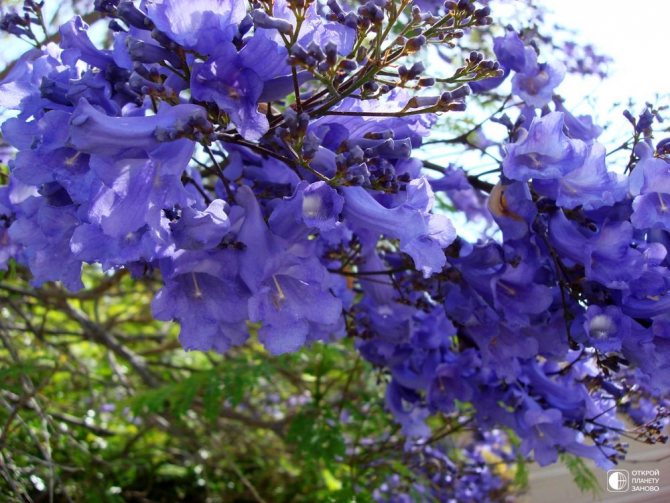
Like any southern inhabitant, indoor jacaranda requires bright lighting, constant watering and spraying of leaves. Place a flower pot, more expediently on the western or eastern windows. The care of jacaranda during the flowering period is slightly different.
Plant care at home
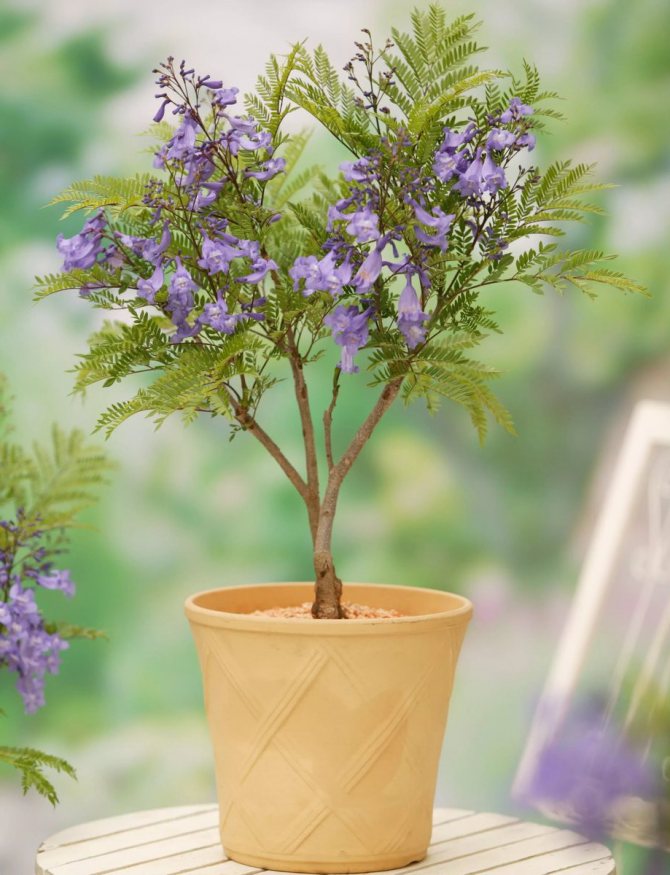
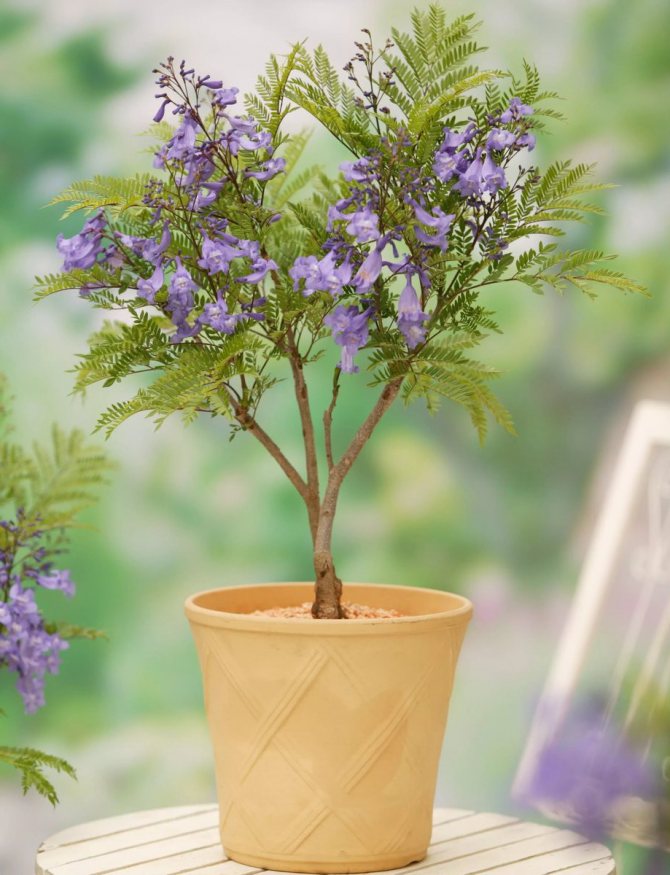
Watering and humidity
Drying out of the soil completely is unacceptable. Watering is carried out regularly. During the period of rest and change of leaves, watering is carried out after the top layer of the earth has dried. Water should be used settled, soft.
Air humidity is also a necessity for the comfortable existence of a flower. Therefore, foliage should be sprayed frequently. It is advisable to place the container with the plant on a pallet with water.
Temperature
Heat-loving jacaranda feels most comfortable at a temperature of + 22 … + 24 C. During the dormant period, from November to February, when the plant sheds leaves, the air temperature can be lowered to + 17 … + 19 C. At temperatures below + 15, the plant may die …
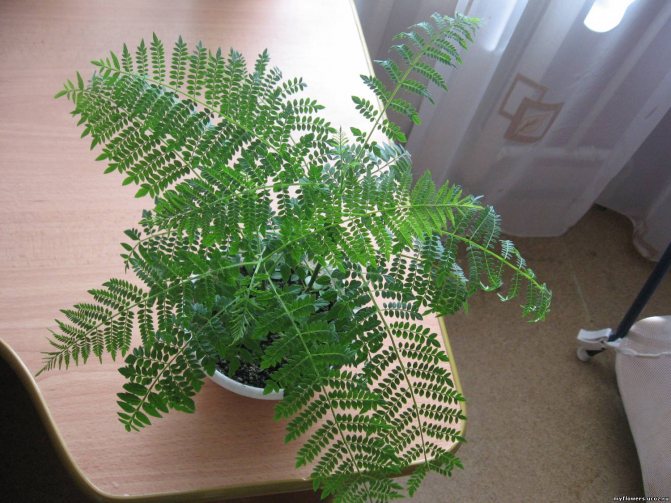
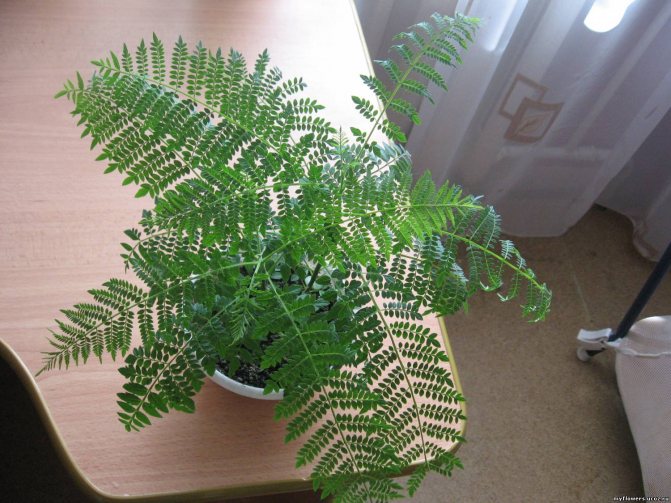
One of the characteristics of the rosewood tree is its rapid growth. As you know, mineral fertilizers stimulate the growth of a plant, therefore, to contain it, it is enough to feed indoor jacaranda once every 3 weeks. In autumn, winter and when leaves fall off, feeding should be stopped. Fertilizers are purchased from specialized stores. It is advisable to alternate mineral fertilizers with organic ones.
To keep the shape of the crown of the tree in a spectacular state, in spring, young shoots must be pinched. Branches that are knocked out of the general view can be cut off.
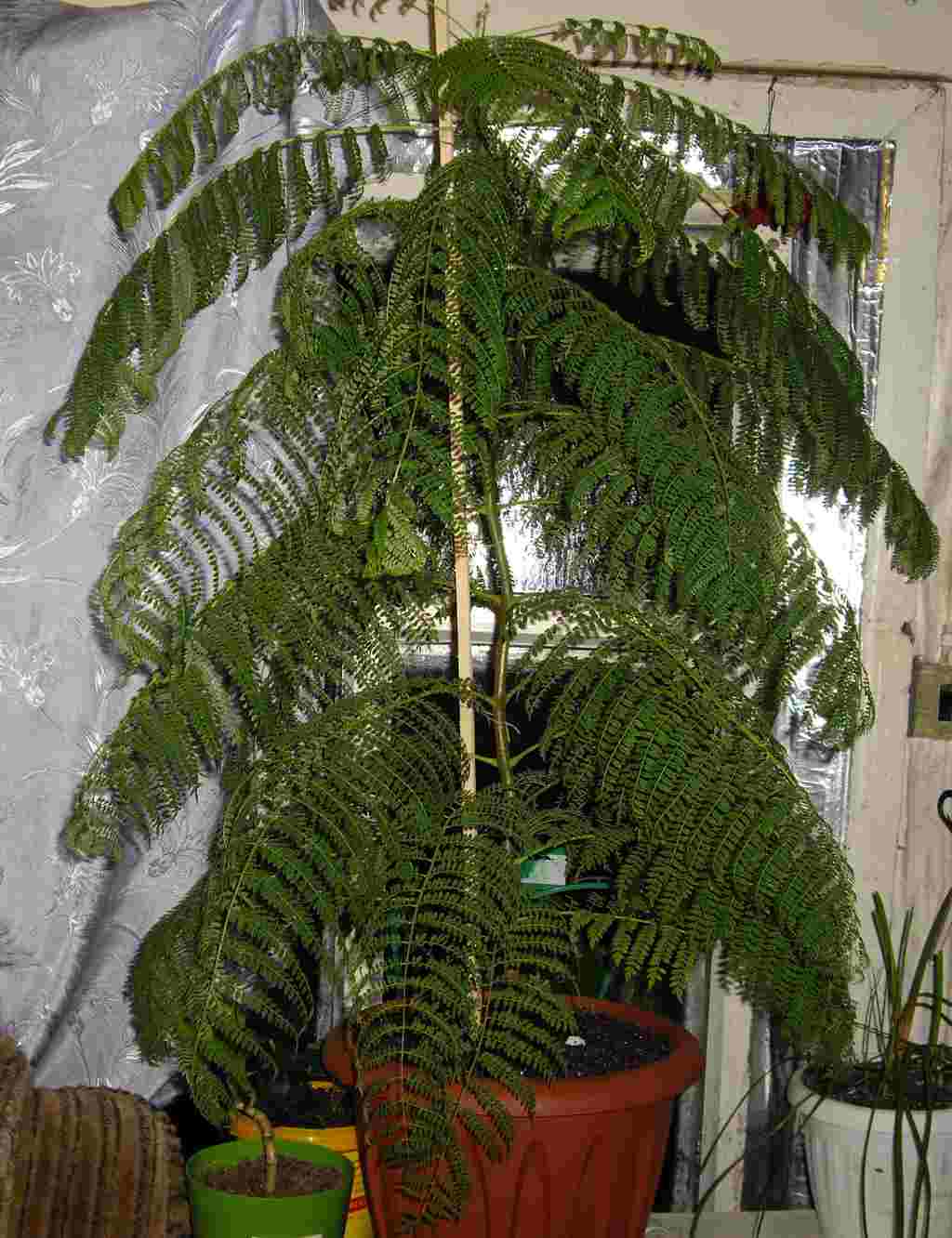
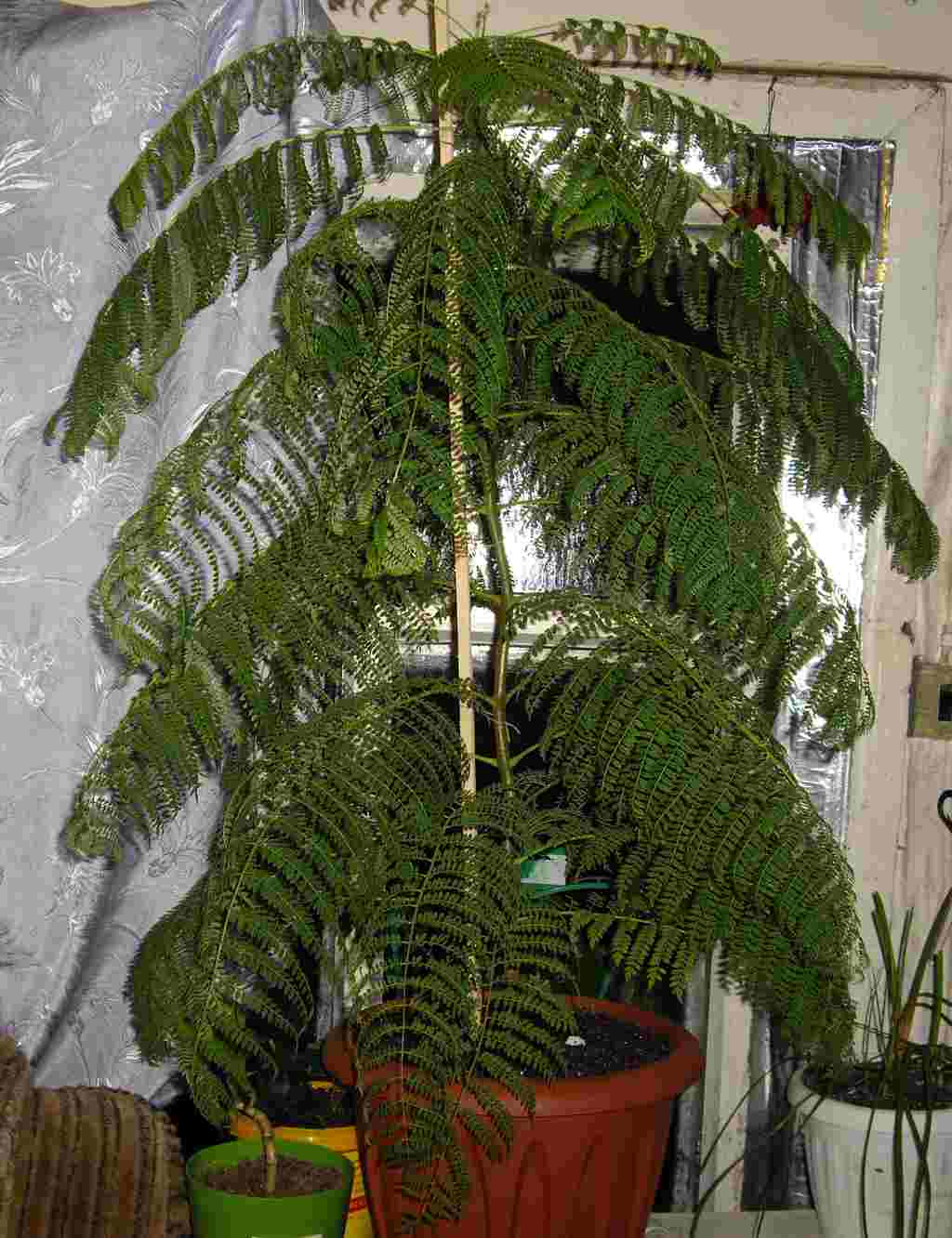
Комментарии (6)
Evgenia Ivanovna
23.03.2018/00/18 at XNUMX:XNUMX |
I have such a tree growing on the windowsill, but I will sell it, as it has grown large enough and began to take up a lot of space. I like the growing process itself. And you?Reply
Julia Expert Plodogorod
16.02.2020/23/25 at XNUMX:XNUMX |
Hello Evgenia Ivanovna! If your specimen is already too large for home growing, it is really better to transplant it in more suitable conditions. To decorate your window with this decorative crop again, we recommend taking a stalk from your jacaranda and enjoying growing again.
It is best to take breeding material in May or early summer. Both stem and apical cuttings are suitable. After the desired part of the shoot is cut, it must be dried in a shaded place. It is better to make a cut obliquely, so the area on which the roots will appear will turn out to be larger. In the future, this will improve the nutrition of the culture.
While the cutting dries up, you can prepare the substrate. It must be loose and disinfected. The basis is sod and leafy soil, to which peat and sand are added. Before diving into the ground, a 7-9 cm segment must be treated with a growth stimulator, and the lower pour must be removed.
After the cutting is planted in damp ground, the container with the plant must be placed in a place where the temperature is about 24-26 degrees. You can cover the landing with a bag or film. Once a day, it is worth ventilating the plant, spraying it with warm water and checking if the soil is dry.
If several cuttings are taken, after successful rooting, they must be planted in separate containers. It is impossible to take too large pots, this will lead to decay of the roots.
Reply
Felix
24.12.2018/03/51 at XNUMX:XNUMX |
Over the past 5 years, my sister has already tried to grow this “miracle” twice. A year ago, once again, the plant died. First, the leaves turn pale, then curl and fall … I treated it with a special preparation, disinfected the soil with potassium permanganate, and it’s useless. Apparently, too whimsical tree. Going to buy for the third time …
Reply
Julia Expert Plodogorod
26.12.2018/19/47 at XNUMX:XNUMX |
Hello Felix! If jacaranda loses its leaves in the spring or winter, then this is a normal seasonal phenomenon. During this time, the tree should be moved to a cool place and the frequency of watering should be reduced. After a while, young leaves usually appear. But if this did not happen, then it is worth examining it for pests. Please note that adult plants get rid of the lower leaves completely, and this is also characteristic of this tree and does not indicate a disease.
Another reason that leaves fall can be an infection with a spider mite, aphid, and also a whitefly. A characteristic feature of ticks is the appearance of a cobweb on the shoots. If you look closely, you can see the perpetrators of the problem themselves. First of all, it is recommended to wash the plant in the shower. You can even use soap or dishwashing detergent to do this. But, make sure that no water gets into the pot, otherwise the plant will rot. To do this, keep the container with the flower slightly tilted. Then you need to treat it with insecticides. In the event of a tick attack, be sure to spray your pet several times. For preventive purposes, it is necessary to maintain sufficient air humidity.
If the flower is attacked by aphids, then the leaves curl and fall off, and also become sticky to the touch. Whitefly are green larvae on the back of leaves. To combat the listed pests, you need to use insecticides, for example, spray with Aktellik or Confidor.
In addition to all of the above, improper care, and, above all, a lack of moisture, can lead to foliage falling. The soil must not completely dry out. It will be better if you use water that has stood.
Reply
Ira
16.04.2019/13/54 at XNUMX:XNUMX |
I did not know at all that the violet is a tree, and not just a beautiful flower. It turns out that if you approach it correctly, then it will be possible to grow a small tree in room conditions?
Reply
Julia Expert Plodogorod
16.04.2019/21/19 at XNUMX:XNUMX |
Hello Ira! If you mean an ordinary violet, then it will not work to grow a tree from it, regardless of what conditions for growing will be provided.
The habitual indoor violets and the violet tree even belong to different families in the biological classification. In the first case, this is the Violet family, and in the second, the Bignonium family.
Probably the reason for the confusion over the alternate name for Jacaranda. It is called the violet tree because of the lilac-purple hue of the buds and the delicate honey aroma. Although, the flowers themselves do not resemble violets in the shape of buds. It is rather a kind of bell.
We would like to note that sometimes the plant described is also called a fern tree, since its foliage resembles a fern.
Although this plant can be cultivated in an apartment, the main problem is that it will begin to bloom in about 8 years. And even this option can be called good luck, since, in principle, it is difficult to achieve flowering from Jacaranda at home.
Even despite the lack of flowering, many growers note that this plant is already quite decorative.
The tree will need a lot of light, so you should think about a place for it in advance. It is good if the windows face west or east. It is important to turn the pot so that the rays of the sun evenly fall on all parts and the plant does not begin to deform.
The temperature should not drop below 15 degrees. Otherwise, the tropical pet will die. The most important condition is humidity. At a minimum, you need to put a pot with a tree on a pallet with wet expanded clay. Daily spraying is also required.
A good option in this case is to use a small room humidifier. If the described conditions are met, then the tree will delight you with lush, healthy and decorative foliage.
Reply
Diseases and pests
In apartment conditions, jacaranda can be attacked by: aphids, whiteflies, scale insects and spider mites.
A small whitefly midge signals its appearance by green larvae on the underside of the leaves. They suck sap from the plant, which provokes yellowing and foliage. In the fight against them, insecticides, applied twice a week, help; it is advisable to collect the larvae by hand.
Aphids also damage the leaves and cause them to curl. Young shoots are also damaged by aphids. Damaged leaves and young ones become sticky. If the plant is not badly damaged, you can do with soapy water, otherwise Fitoverm and Deris are used.
When damaged by a spider mite, the thinnest cobweb appears on the underside of the leaf. The main reason for the appearance of a tick is a lack of moisture in the air. Jacaranda is treated with insectoacaricides, air humidity is maintained in the room, leaves are sprayed.
If the tree is not given proper attention, it can get sick.
- Dry air, soil, cold and draft will cause the leaves to curl and turn yellow.
- Soil deficient in iron, sulfur and zinc can lead to leaf chlorosis.
- Drainage of the soil is required, do not get carried away by overflow – this leads to rotting of the roots.
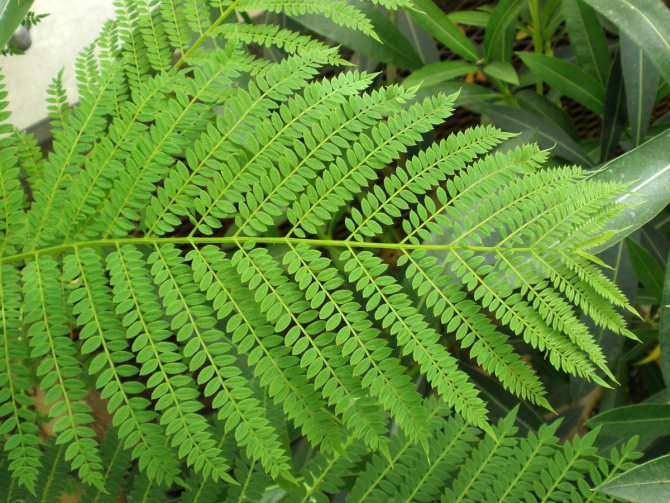

Transplantation and reproduction
When growing jacaranda, it is important to remember that the plant itself will let you know when it is time to change the container. As soon as the roots fill the pot completely, it’s time for the plant to change its place of residence.
Untimely transplanting can affect the growth of the plant. The tree is transplanted in the spring. We choose a container 2-3 cm wider in diameter than the previous one. We spread the bottom with drainage, you can prepare the soil yourself. To do this, mix:
- leafy ground – 4 parts;
- humus – 2 parts;
- peat – 2 parts;
- sod soil – 2 parts;
- sand – 1 part.
Growing jacaranda from seeds
Seed propagation and cuttings are possible.
- Seeds are sown in spring, in March-April.
- Before sowing, the seeds must be wrapped in a damp cloth and kept in a warm place for XNUMX hours.
- Cover the seeds by 1 cm, it is better to plant one at a time in cassette cups, water well.
- Cover crops with a bag, put in a shaded place and maintain the air temperature within 22-25 ° C.
- Expect sprouting 14-20 days.
- When all the seeds have sprout, the cover can be removed and gradually accustom the sprouts to a brighter light.
- Plant the hardened seedlings by transferring them into separate pots with a diameter of no more than 7 cm. Substrate: one part of humus, peat soil and sand with the addition of 2 parts of sod land.
Jacaranda (violet tree).
Jacaranda is a genus of flowering trees from the bignonium family, which includes 50 plant species. Its other name – the violet tree – it got thanks to the lilac-purple shades of flowers and a delicate honey aroma. Jacaranda grows in tropical and subtropical regions of Central and South America, Cuba, Jamaica, Bahamas, and is also widespread in Asia, especially in Nepal. In addition, it is quite common in South Africa, Zimbabwe and Australia, but the main area of their distribution is concentrated in Brazil.

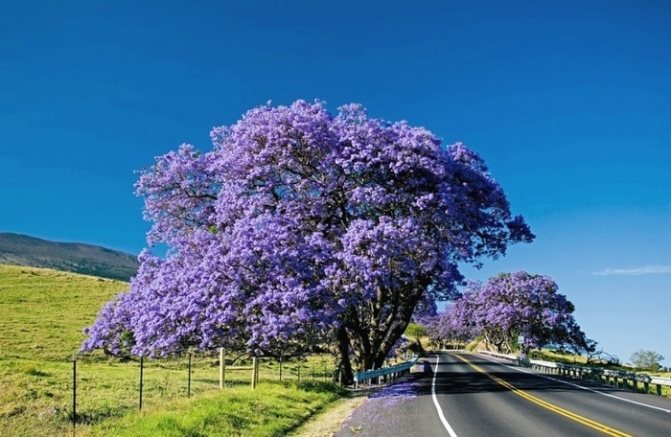
The name of the plant – “jacaranda” – comes from the Portuguese word, which means “having hardwood”. In her native land, she is called Black Pui, and for the shape of the leaves – a fern tree.
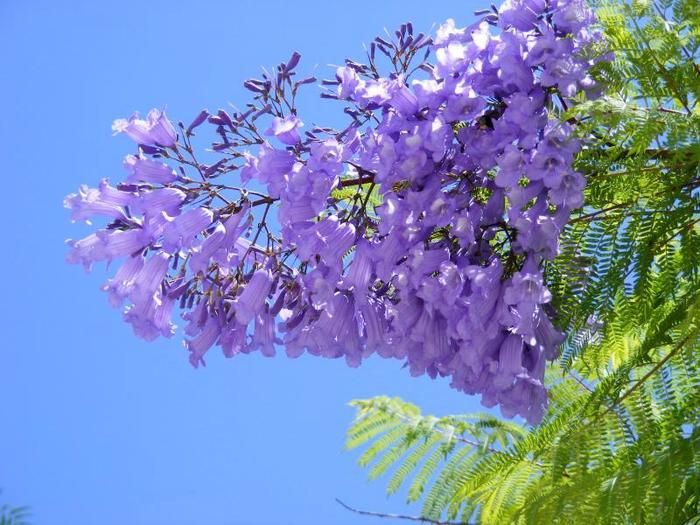

Most of the representatives of the jacaranda genus are evergreen trees with a height of 20 to 30 meters, but there are also small shrubs that do not exceed two meters in height. Plants have feathery, fern-like leaves and bell-shaped, in most cases blue or purple-lilac flowers. Some species have white flowers.

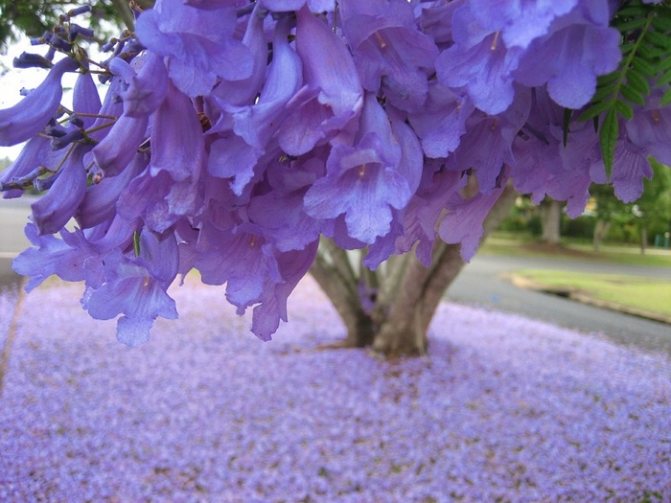
Representatives of the jacaranda genus are exclusively semi-leafy plants that lose their leaves at a temperature of zero degrees. Temperatures below three degrees can destroy young trees; mature plants can withstand temperatures up to -7 degrees. Collected in a brush, bell-shaped flowers have a length of 5 cm. Basically, one brush includes several dozen lilac fragrant flowers. Under their weight, branches can hang almost to the very ground, and the sticky nectar of a violet tree often stains parked cars and the clothes of people passing by. At the end of the flowering period, seed pods are formed in place of the flowers, which soon burst, scattering a huge number of lionfish seeds many meters from the mother plant.
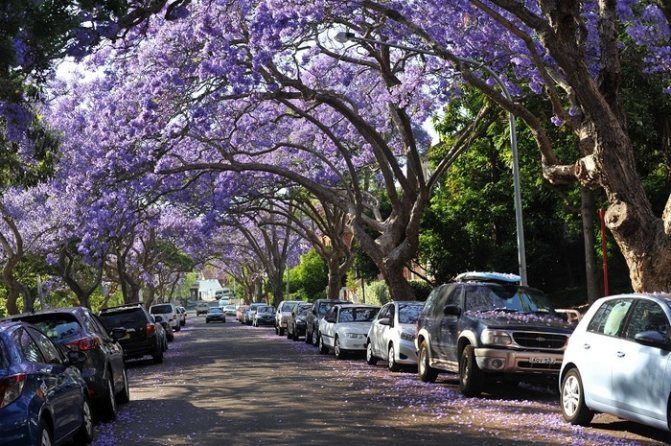
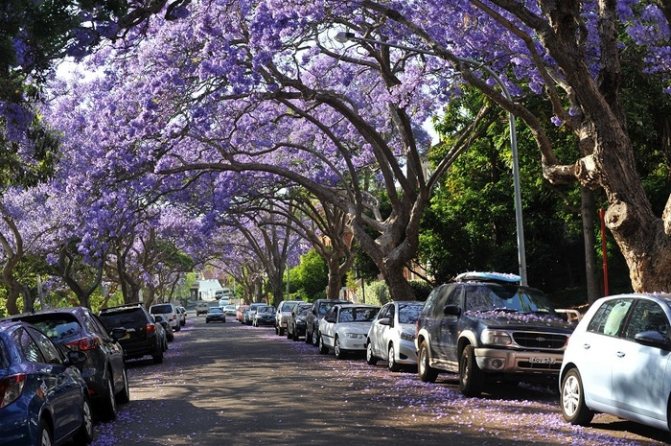
Jacaranda is prized not only for its stunning appearance, but also as a source of valuable wood, from which furniture, musical instruments, souvenirs and all kinds of luxury goods are made. When polished, the core of this plant turns red-brown, with a slight purple tint. And the scent of fresh wood exudes a unique violet scent.
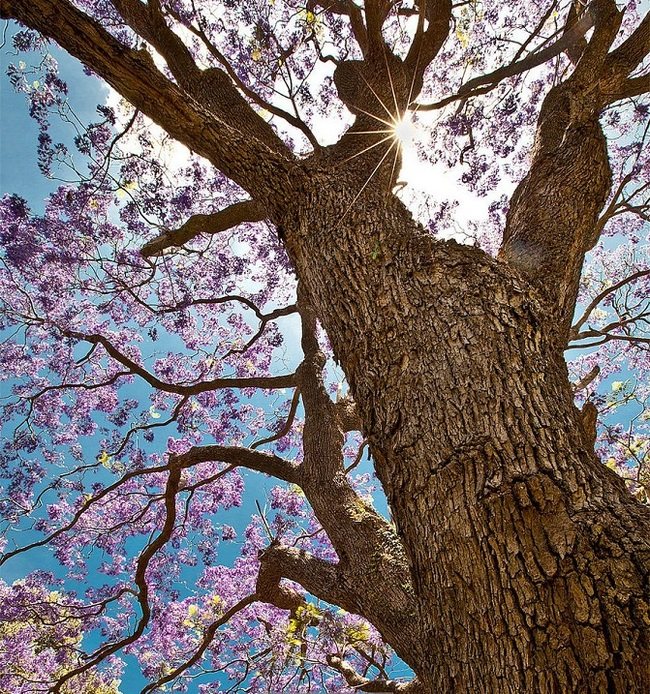
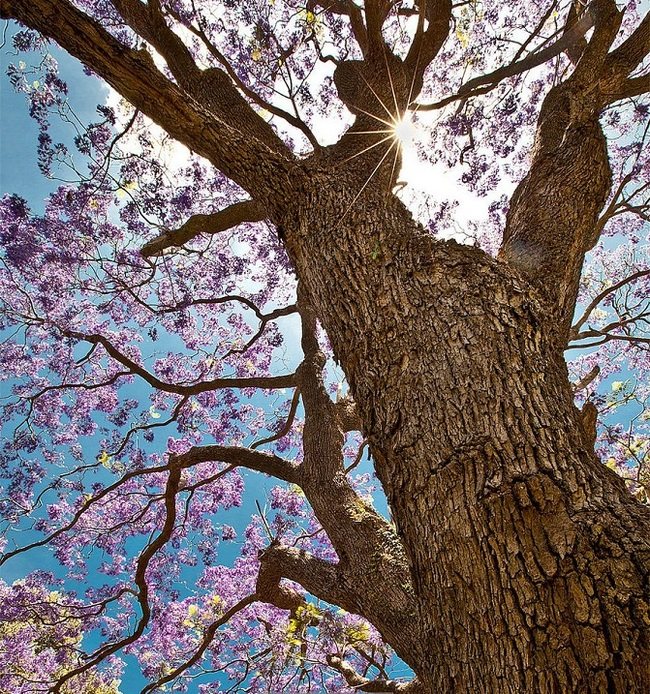
In their native lands, jacaranda trees are of great importance and are shrouded in many legends, myths and signs. For example, in Zimbabwe and Mexico, the flowering of the violet tree symbolizes the arrival of spring. Some African tribes believe in the Blue Spirit that lives in the plant, which invariably contributes to the issuance of correct verdicts when resolving conflicts between people. Elsewhere, older women examine the various complaints of tribal members under these trees – the Blue Spirit always helps to make the right decision. In Australia, the most common type of jacaranda with white flowers. Australians associate its flowering with Christmas. Love for a beautiful plant gave rise to the emergence of such a tradition – at the birth of a child, parents or other relatives of the baby must plant a new tree.
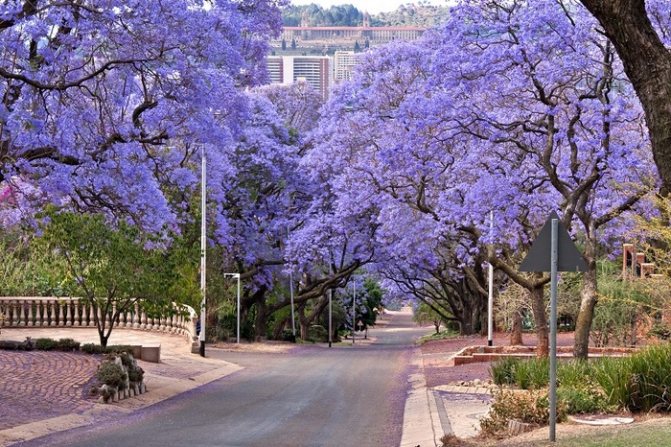
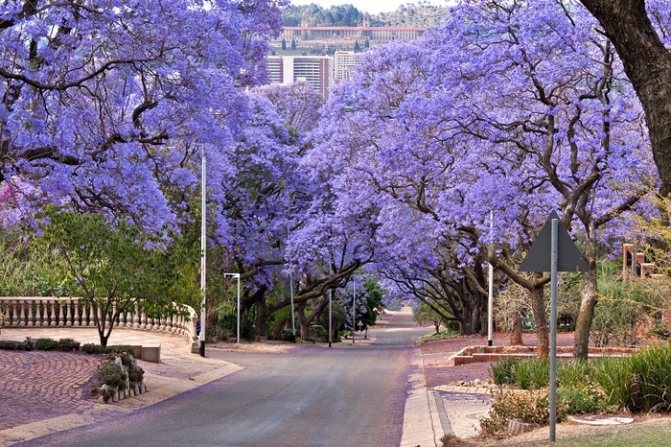
There is a legend that tells of the daughter of the Moon, a beautiful priestess who flew to people on the bird Mitu. Decorated with flowering jacaranda branches, the girl sat in the shade of a huge violet tree and gave people her wisdom and knowledge of the centuries. Soon the priestess left her place and flew into the jungle. After this incident, jacaranda received another name – the tree of knowledge. Under the influence of a beautiful legend, they began to plant it next to educational institutions. For example, many universities in Sydney believe that studying materials and preparing for exams should be done before the jacaranda blooms. Another sign is also common among students – the exam will be passed perfectly if a violet tree flower falls on the head, and a flower caught on the fly will also bring good luck.
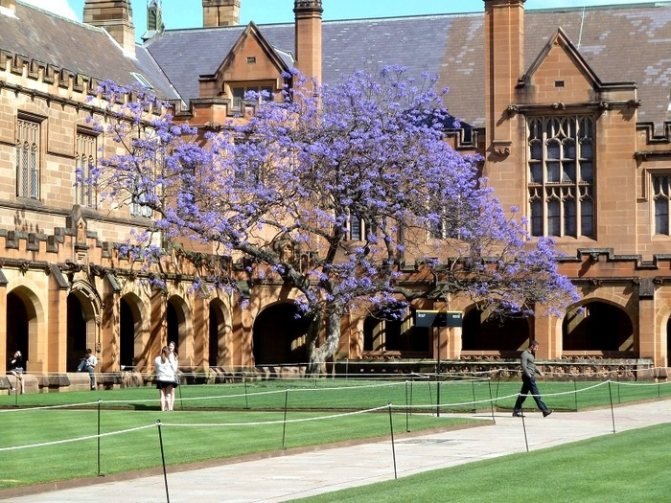
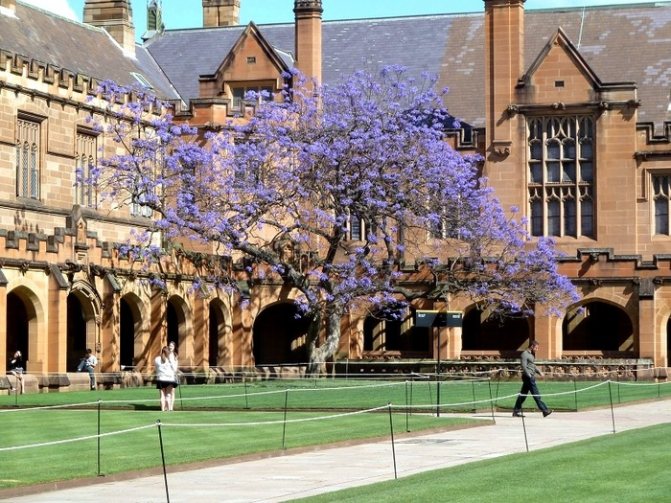
The many advantages of jacaranda include its healing abilities – in South American folk medicine, it is used in the treatment of infections. It has been confirmed that the extract of flowers and leaves of the violet tree fights E. coli much more effectively than many antibiotics, without causing any side effects.


The spectacular flowering of the violet tree lasts about two weeks, which is why it is grown as an ornamental plant in many areas with favorable climates. Particularly popular is the type of mimosa jacaranda (Jacaranda mimosifolia), the large leaves of which are similar to the leaves of a fern or mimosa. Several species of this plant are grown indoors. However, this process is rather complicated, since trees need conditions as close to natural as possible for normal development.
How does it bloom?
Inflorescences appear at the ends of the branches, crowning each cluster of them. During spring flowering, buds also appear in the axils of leaf rosettes.
The flowers are lilac-blue, violet and purple, the stigma of the bell is up to 5 cm long, the diameter of the lower corolla at the pedicel is usually 3 cm, rarely more. Outwardly, it looks like the growth of a gradually expanding gramophone from the flat and pubescent calyx of the main flower along the edges of the petals.
The petals can have white or yellowish small markings, adding beauty and decorativeness to each flower and bouquets of inflorescences. The scent of blooming jacaranda is reminiscent of the scent of fresh honey.
